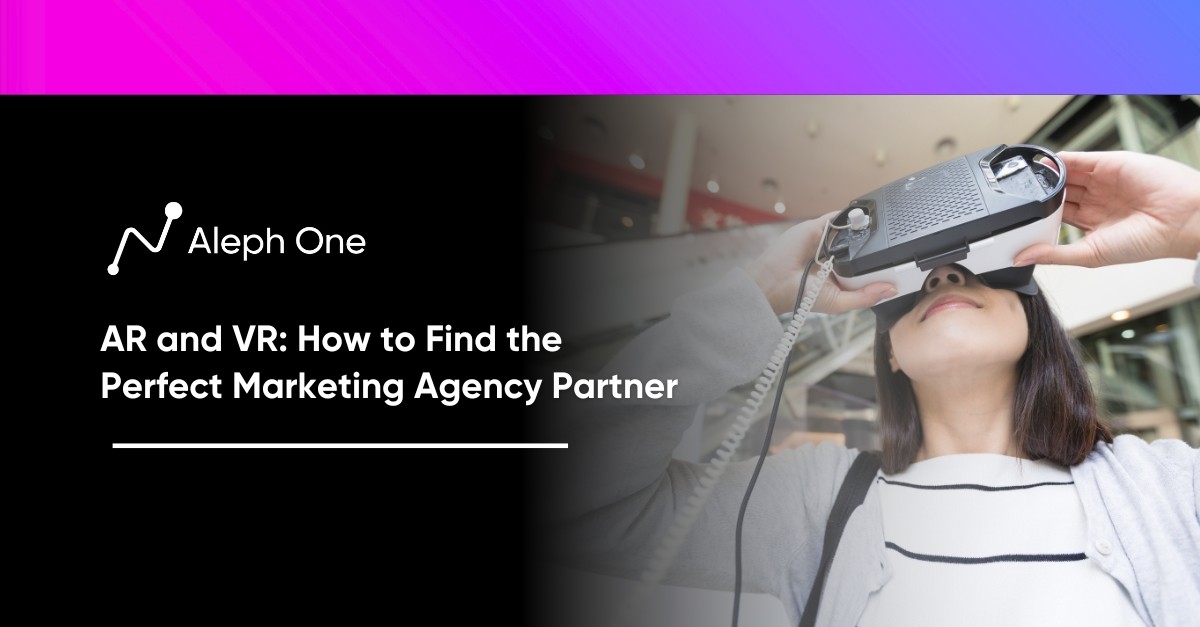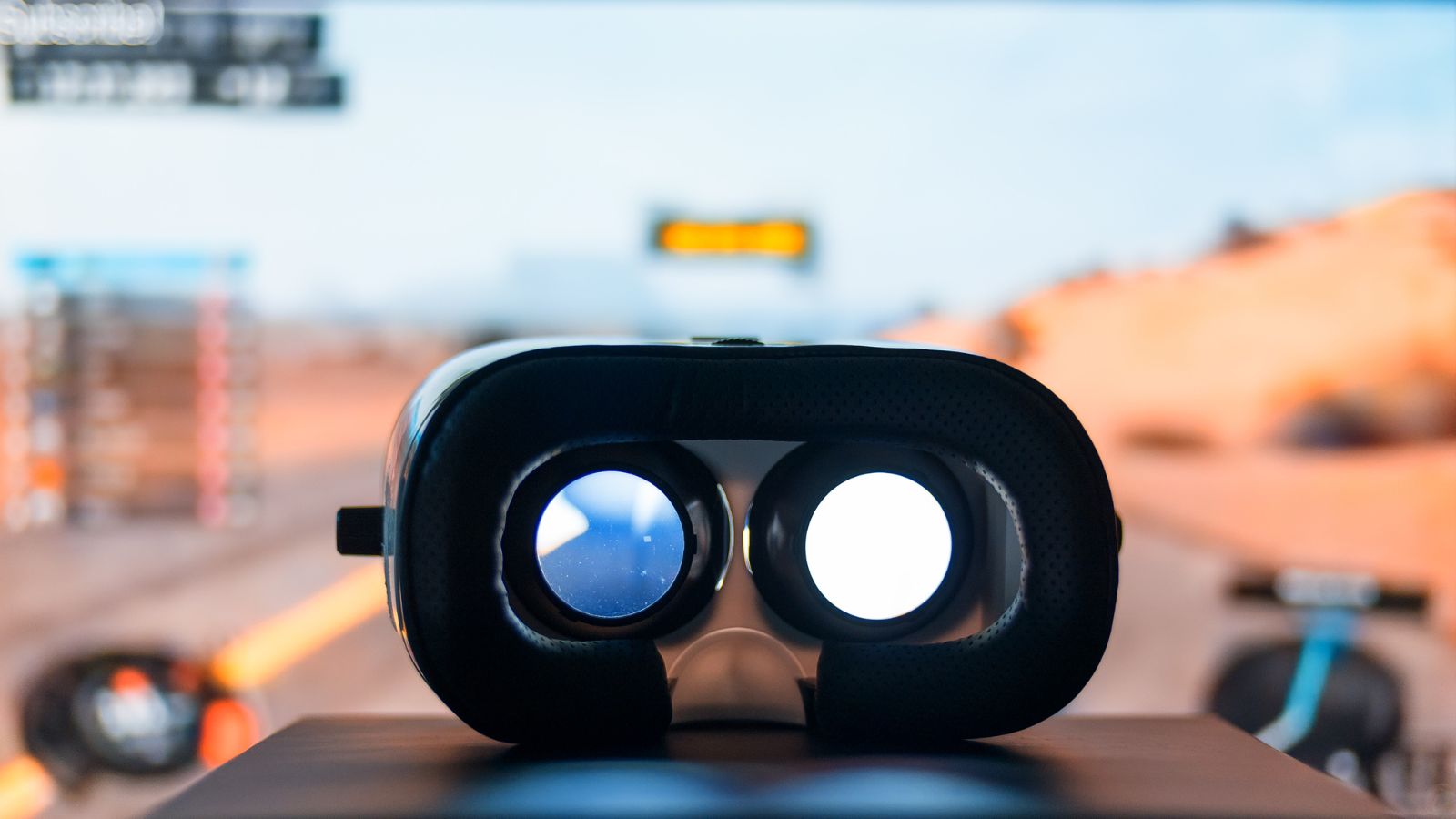Let’s work together to build something amazing. Share your project details and our team will reply to figure out the next steps to your success.

As augmented reality (AR) and virtual reality (VR) continue to gain momentum, brands seek to harness these immersive technologies’ power to elevate their marketing strategies. AR and VR offer unprecedented opportunities for creating engaging, interactive experiences that captivate audiences and drive meaningful results. However, to fully unlock the potential of AR and VR, brands need the expertise and guidance of a skilled marketing agency partner. This article explores the significance of AR and VR in today’s digital landscape and provides insights into choosing the right agency to navigate this rapidly evolving landscape. By understanding the unique capabilities and considerations of AR and VR marketing, brands can forge strong partnerships and propel their marketing efforts to new heights of success.

The Rise of Immersive Technologies: How AR and VR Have Captured the World’s Attention
Augmented and virtual reality have advanced rapidly in recent years, transforming how we interact with technology and opening up new creative possibilities for brands. The global AR market is projected to reach $73 billion by 2024, while the VR market is expected to hit $20 billion by 2022.
Tech Giants Embrace Immersive Technologies
Some of the biggest names in tech have launched new AR and VR products, demonstrating the huge potential of immersive technologies. In 2020, Apple released its LiDAR Scanner for more immersive AR experiences on iPhones and iPads. The company is also rumored to be developing AR smart glasses, demonstrating its belief in AR as a key platform of the future.
Advancements in AR and VR Products
Meanwhile, Facebook launched the Oculus Quest 2 virtual reality headset in 2020, a successor to the popular Oculus Quest. The Quest 2 presents an all-in-one, wireless VR experience at an affordable price point, helping to drive mainstream interest in virtual reality. Qualcomm has also developed a new wireless VR technology called WiGig, enabling tetherless, high-performance VR on devices like the Quest.
The Growing Importance of AR and VR in Brand Engagement
As AR and VR become more advanced and widely adopted, they enable brands to engage with customers in entirely new ways through interactive and memorable experiences. According to a recent report, 71% of people think AR and VR are the future of brand engagement and shopping. By embracing immersive technologies today, brands can unlock powerful opportunities to captivate audiences, build deeper connections, gain data-driven customer insights, and drive real business impact. The future is immersive, and leading companies are now investing in AR and VR to shape the next digital marketing and commerce era.
Why Every Brand Needs an AR/VR Marketing Strategy
Augmented and virtual reality have moved from science fiction into the mainstream, and they present a huge opportunity for brands to transform how they engage with customers. According to research by Omdia, the AR/VR market is set to be worth over $20 billion by 2024, demonstrating the scale of investment in these technologies.
Captivating Audiences with AR and VR
For marketers, AR and VR unlock creative possibilities for interactive, immersive experiences that captivate audiences. By transporting people into a virtual world, brands can make a memorable impression and form deeper connections with customers. Studies show that experiences stimulating our senses are far more impactful and memorable. Using AR and VR, brands can activate touch, sight, and sound to craft experiences their customers will remember.
Data-Driven Insights and Understanding Customer Behavior
These technologies provide data-driven insights into customer behavior. By analyzing how people interact with AR and VR content, brands can better understand what resonates with their audience. They can see what products, features, or pieces of content capture people’s attention. These data-driven insights allow marketers to optimize the customer experience.
Using Immersive Technologies for Marketing Strategies
Major brands like Nike, Ikea, and Lego are already innovatively using AR and VR. Nike created an AR app that allowed customers to scan their feet to determine their perfect shoe size. Ikea developed an AR app so people can see how furniture will look in their own homes. Lego has an AR experience where people can play and interact with life-size Lego characters and sets. These examples demonstrate the huge potential for brands to leverage AR and VR to drive engagement and build brand loyalty.
Staying Ahead in the Immersive Future
With the widespread adoption of devices like smartphones, tablets, and wearables, the platforms and tools now exist for brands of all sizes to incorporate immersive technologies into their marketing strategies. As the capabilities of AR and VR continue to expand and consumers become more familiar with the possibilities, brands that fail to explore these emerging channels risk getting left behind by competitors. The future of digital marketing is immersive, and every brand needs an AR/VR strategy to stay ahead of trends, drive innovation, and forge deeper connections with their customers.
How to Choose the Right AR/VR Marketing Agency
Selecting the right AR/VR marketing agency is crucial for brands looking to unlock the potential of these immersive technologies. There are a few key considerations to keep in mind during the selection process:
Experience and Expertise
Look for an agency with a proven track record of delivering impactful AR/VR campaigns for other brands. They should have expertise across the key areas of AR/VR marketing, from interactive experiences to virtual events to eCommerce solutions. Ask to see case studies of their previous work to assess the quality and innovation.
Creative Abilities
The agency needs a highly creative team to develop engaging AR and VR concepts tailored to your brand. They should be able to bring your brand vision to life through the latest immersive formats and features. Review the profiles of their creative staff to ensure they have the skills required.
Technical Capabilities
AR and VR marketing relies heavily on advanced technologies, so the agency must have a dedicated team with 3D modeling, coding, and software development expertise. They should work with industry-leading AR/VR platforms and tools. Ask about their development process to see if they follow the latest best practices.
Data-Driven Approach
In today’s digital world, marketing campaigns must be data-driven to achieve the best results. The agency should take a metrics-focused approach to developing your AR/VR marketing strategy. They need to be able to track key performance indicaators, gain customer insights, optimize the experience in real-time based on data, and report on ROI. Discuss their data and analytics capabilities in detail.
The selection process should also involve checking client testimonials and references, reviewing industry awards and partnerships, and asking the agency questions about their team, experience, tools, and approach. With many agencies now offering AR and VR marketing services, finding the perfect partner will help ensure your brand campaign achieves its full potential. The right agency can elevate your brand to the next level through the power of immersive technologies.
The Power of AR/VR for Immersive Events
AR and VR technology can be leveraged to create engaging virtual and hybrid events that provide an immersive experience for attendees. By incorporating interactive AR and VR features, brands can boost event attendance, gain valuable data insights, and open up new sponsorship opportunities.
Veuve Cliquot’s AR Experience
For example, Veuve Clicquot used AR to create an interactive champagne bottle experience for attendees of the 2018 Governors Ball Music Festival. A custom AR app allows attendees to scan Veuve Clicquot branded tents to see a virtual champagne bottle burst through the tent’s roof. This shareable AR experience helped to raise brand awareness and boost social media engagement.
Vogue’s VR Runway Shows
Vogue’s 2018 Forces of Fashion conference incorporated VR to stream live runway shows from fashion weeks in London and Milan. Although attendees were in New York, VR transported them to the front row of these exclusive shows, providing an unforgettable fashion experience in action.
Snapchat Blending Real and Virtual
Snapchat’s Landmarkers AR feature has been used by brands like Nike and HBO to create virtual pop-up shops and interactive portals at live events. Event attendees can unlock custom AR experiences by scanning Snapchat codes or physical landmarks like statues. This seamlessly blends the virtual and real world for an immersive event activation.
Measuring Success by Analyzing Metrics
To measure the success of AR/VR events, brands can analyze metrics like attendee numbers, social media mentions and engagements, press coverage, and even sales or website traffic uplift. Surveys and interviews can also provide valuable feedback on the attendee experience.
Boosting Attendance by Gaining Insights with AR/VR
AR and VR open up exciting new possibilities for hosting innovative virtual and hybrid events. By crafting interactive and shareable experiences, brands can boost event attendance, gain data-driven customer insights, and unlock new sponsorship and partnership opportunities. With the right event strategy and technology partner, brands can stay ahead of trends in the events industry and deliver unforgettable immersive experiences for customers.
Driving eCommerce Sales Through AR/VR
AR and VR are transforming the online shopping experience by allowing customers to visualize and interact with products in new immersive ways. According to research by Accenture, over 40% of consumers are willing to pay more for a product they can experience through AR. By offering virtual product trials and telepresence, brands can boost conversion rates and increase average order values.
Interactive Product Visualization
Interactive product visualization allows customers to view products in different colors and sizes from multiple angles. For example, makeup brand MAC Cosmetics lets customers virtually try on different lipstick shades through their AR mirror app. Home decor brands like Wayfair and Anthropic use AR to show customers how furniture and accessories will look in their home environment. These experiences make it easier for customers to find the right products, increasing the likelihood of a purchase.
Virtual Product Trials
Virtual product trials allow customers to experience what a product feels and sounds like. Sporting goods brands like Nike and Adidas offer AR apps that let customers virtually try on shoes to get the right fit before buying. PepsiCo’s “Shoppable AR” campaign allowed customers to experience the sounds of opening and drinking a can of Pepsi through AR. According to research, over 70% of customers want to experience more senses through AR when shopping online.
Telepresence
Telepresence uses AR and VR to make the eCommerce experience more human. For example, beauty brand Charlotte Tilbury launched an AR virtual makeup artist app that uses a front-facing camera to apply makeup to the customer’s face in real time. The virtual makeup artist can provide tailored makeup tips and recommendations as if the customer were present in-store. Fashion retailers like ASOS and L’Oreal are experimenting with virtual influencers and stylists to offer style inspiration and advice through AR and VR.
With AR and VR advancing rapidly, brands have an opportunity to transform how customers shop online through immersive and multi-sensory eCommerce experiences. By adopting technologies like interactive product visualization, virtual trials, and telepresence, brands can boost sales, increase customer satisfaction and gain valuable data-driven insights into customer preferences and behavior. The future of eCommerce is immersive.
The Future of AR/VR Marketing: What’s Next?
AR and VR technologies are advancing rapidly, and marketing applications will continue to push boundaries in the coming years. With the rollout of 5G providing faster connectivity and lower latency, AR and VR experiences will become even more immersive and seamless. Computer vision, voice technology, and haptics will enable new multi-sensory brand activations that provide personalized experiences at scale.
Hyper-Personalization: Tailoring AR/VR Content to Individual Customers
Hyper-personalized experiences will allow brands to tailor AR and VR content to individual customers in real-time based on their location, interests, and behavior. For example, a retailer could provide shoppers customized virtual coupons and product recommendations based on their purchase history and profile when they enter a store. Multi-sensory brand activations will immerse customers in interactive experiences that stimulate sight, sound, and touch. For example, an automotive brand could allow customers to visualize, interact with, and explore new vehicle models using haptic gloves and bodysuits.
Optimizing Customer Experience on the Fly
Real-time data-driven adaptations will enable brands to optimize the customer experience based on how people engage and respond. For example, if one part of an AR game or VR show isn’t resonating well with audiences, brands can make instant changes to improve enjoyment and impact. As technology improves, these experiences will become highly responsive to individual customers and overall audience reactions.
A Proactive Approach to AR/VR Marketing
To stay ahead of these trends, brands need to start exploring the possibilities now through pilot programs and partnerships with innovative AR/VR marketing agencies. They must also invest in building the technological capabilities and data infrastructure required to power highly personalized, multi-sensory experiences at scale and in real-time. The future of AR/VR marketing is extremely promising, but brands must be proactive to unlock their full potential. With the right strategy and partners, AR and VR can transform how brands engage with and sell to customers over the next decade.
FAQ
What are some key trends in AR/VR technology that can potentially impact digital marketing and commerce in the coming years?
Some key trends include the advancement of computer vision, voice technology, and haptics. Faster connectivity and lower latency with the rollout of 5G will also provide more seamless AR/VR experiences. Hyper-personalized experiences that tailor content to individual customers based on their location, interests, and behavior is another key trend. These trends can significantly enhance the interactivity and personalization of digital marketing, aiding brands to create more engaging and impactful customer experiences.
How can brands better utilize AR and VR technologies to create unique and more immersive customer experiences?
Brands can better utilize AR/VR technology to create immersive customer experiences by continuously exploring and testing the latest technological advancements. This includes deploying technologies like interactive product visualization, virtual trials, and telepresence in their marketing strategies. Brands should also aim to provide hyper-personalized experiences tailored to individual customers. This requires investment in technologies that can gather and analyze customer data to deliver real-time personalization.
What are the significant challenges that brands might face in integrating AR and VR technologies into their marketing strategies and how can they overcome these?
Some challenges brands might face include technology adoption and integration, privacy concerns, and the need for significant financial investment. To overcome these, brands can collaborate with seasoned AR/VR agencies with the required expertise and experience. They can also leverage scalable technologies that offer cost-effective solutions for deploying AR and VR. Additionally, they must adopt clear data usage policies to allay customer privacy concerns. Training for staff to handle new technologies may be required as well.
Get the latest news and updates from Aleph One in your inbox.



